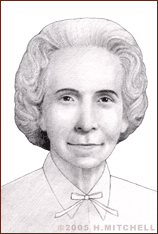Allene Jeanes
Listed among the ingredients of countless foods, such as salad dressing, ice cream, canned soup, and condiments, is a mysterious-sounding substance called xanthan gum. This groundbreaking product and a process for producing it in large quantities was discovered in the 1950s by chemist Allene Rosalind Jeanes. It has since become an indispensable thickening and texturizing agent not only for foods but also for a wide range of cosmetic, automotive, and healthcare products.
Jeanes, born in Waco, Texas on July 19, 1906, earned a BA from Baylor College and an MA from the University of California at Berkeley before moving to Alabama to teach at Athens College for five years from 1930 to 1935.
From there, she decided to return to school, earning a PhD in organic chemistry in 1938 from the University of Illinois, where, during the course of her studies, she developed a specialization in carbohydrates research.
After completing her doctoral work, Jeanes accepted a position with the National Institutes of Health in Washington, D.C., where she served as a corn industries research foundation fellow until 1940, when she moved on to the U.S. Department of Agriculture’s Northern Regional Research Lab (NRRL) in Peoria, Illinois. She spent the majority of her career with the NRRL, remaining with the organization until her retirement in 1976.
At the NRRL, Jeanes’ work included research on polysaccharides, or large molecules made of chains of thousands of sugar molecules. One of the polysaccharides that she was most interested in was dextran, a substance that was difficult to find in nature but had a desirable, viscous quality.
Jeanes unexpectedly discovered a way to easily make dextran in large quantities when a soft drink company sent a sample of a soft drink that had mysteriously become thick and gooey to her lab. They wanted the lab to find out what had happened to it.
Jeanes determined that a type of bacteria had contaminated the soda pop, which happened to produce dextran. The presence of this substance in the drink had caused it to become thick and syrupy. With this stroke of luck, Jeanes was able to easily isolate these bacteria to make dextran at will. At the time, researchers had been considering the possibility of using dextran to extend blood plasma. By using such a substance, a person who had lost a great deal of blood could potentially be kept alive longer – long enough to get a lifesaving blood transfusion.
The Korean War erupted shortly thereafter, in 1950, and when the U.S. got involved, dextran was quickly put into production for the purpose of treating injured soldiers. It proved quite effective and was used by civilian physicians after the war had ended.
This work preceded Jeanes’ discovery of the process for making xanthan gum, another type of polysaccharide that has an excellent thickening quality for foods, cosmetics, medicines, and industrial substances. The substance, made by the bacteria Xanthomonas campestris in the fermentation of glucose, also keeps foods such as oil and vinegar from separating. It is also used to prevent ice crystals from forming in ice cream products and to add “cling” to foods, as well as a gluten substitute in breads for allergy sufferers. Xanthan gum found widespread use around the world and has become the most mass-produced polysaccharide in existence.
Over the course of her career, Jeanes received 10 patents and produced 60 publications related to her work and discoveries. She was honored with a variety of awards for her accomplishments, including the 1953 Distinguished Service Award from the U.S. Department of Agriculture. She was the first woman to ever receive this honor. She also received the Garvan Medal from the American Chemical Society in 1956 and the Women’s Service Award from the U.S. Civil Service Commission in 1962.
She died on Dec. 15, 1995 at the age of 89.


